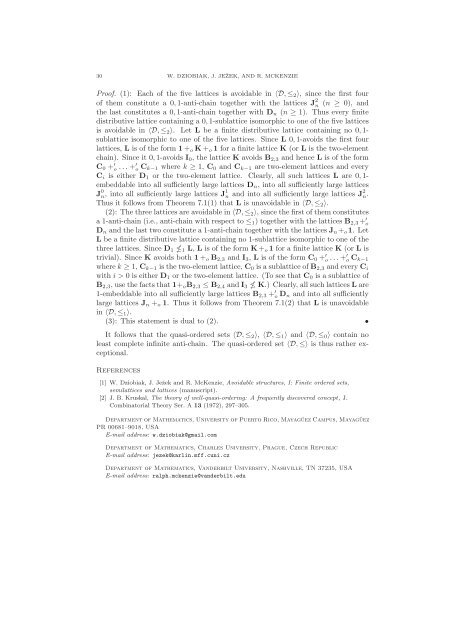Avoidable structures, II: finite distributive lattices and nicely ...
Avoidable structures, II: finite distributive lattices and nicely ...
Avoidable structures, II: finite distributive lattices and nicely ...
Create successful ePaper yourself
Turn your PDF publications into a flip-book with our unique Google optimized e-Paper software.
30 W. DZIOBIAK, J. JEŽEK, AND R. MCKENZIE<br />
Proof. (1): Each of the five <strong>lattices</strong> is avoidable in 〈D,≤ 2 〉, since the first four<br />
of them constitute a 0,1-anti-chain together with the <strong>lattices</strong> J 2 n (n ≥ 0), <strong>and</strong><br />
the last constitutes a 0,1-anti-chain together with D n (n ≥ 1). Thus every <strong>finite</strong><br />
<strong>distributive</strong> lattice containing a 0,1-sublattice isomorphic to one of the five <strong>lattices</strong><br />
is avoidable in 〈D,≤ 2 〉. Let L be a <strong>finite</strong> <strong>distributive</strong> lattice containing no 0,1-<br />
sublattice isomorphic to one of the five <strong>lattices</strong>. Since L 0,1-avoids the first four<br />
<strong>lattices</strong>, L is of the form 1+ o K+ o 1 for a <strong>finite</strong> lattice K (or L is the two-element<br />
chain). Since it 0,1-avoids I 0 , the lattice K avoids B 2,3 <strong>and</strong> hence L is of the form<br />
C 0 + ′ o ...+ ′ o C k−1 where k ≥ 1, C 0 <strong>and</strong> C k−1 are two-element <strong>lattices</strong> <strong>and</strong> every<br />
C i is either D 1 or the two-element lattice. Clearly, all such <strong>lattices</strong> L are 0,1-<br />
embeddable into all sufficiently large <strong>lattices</strong> D n , into all sufficiently large <strong>lattices</strong><br />
J 0 n, into all sufficiently large <strong>lattices</strong> J 1 n <strong>and</strong> into all sufficiently large <strong>lattices</strong> J 2 n.<br />
Thus it follows from Theorem 7.1(1) that L is unavoidable in 〈D,≤ 2 〉.<br />
(2): Thethree<strong>lattices</strong> areavoidable in〈D,≤ 2 〉, sincethefirstofthem constitutes<br />
a 1-anti-chain (i.e., anti-chain with respect to ≤ 1 ) together with the <strong>lattices</strong> B 2,3 + ′ o<br />
D n <strong>and</strong> the last two constitute a 1-anti-chain together with the <strong>lattices</strong> J n + o 1. Let<br />
L be a <strong>finite</strong> <strong>distributive</strong> lattice containing no 1-sublattice isomorphic to one of the<br />
three <strong>lattices</strong>. Since D 1 ≰ 1 L, L is of the form K+ o 1 for a <strong>finite</strong> lattice K (or L is<br />
trivial). Since K avoids both 1+ o B 2,3 <strong>and</strong> I 3 , L is of the form C 0 + ′ o...+ ′ oC k−1<br />
wherek ≥ 1, C k−1 isthetwo-elementlattice, C 0 isasublatticeofB 2,3 <strong>and</strong>everyC i<br />
with i > 0 is either D 1 or the two-element lattice. (To see that C 0 is a sublattice of<br />
B 2,3 , usethefactsthat1+ o B 2,3 ≤ B 2,4 <strong>and</strong>I 3 ≰ K.) Clearly, allsuch<strong>lattices</strong>Lare<br />
1-embeddable into all sufficiently large <strong>lattices</strong> B 2,3 + ′ o D n <strong>and</strong> into all sufficiently<br />
large <strong>lattices</strong> J n + o 1. Thus it follows from Theorem 7.1(2) that L is unavoidable<br />
in 〈D,≤ 1 〉.<br />
(3): This statement is dual to (2). •<br />
It follows that the quasi-ordered sets 〈D,≤ 2 〉, 〈D,≤ 1 〉 <strong>and</strong> 〈D,≤ 0 〉 contain no<br />
least complete in<strong>finite</strong> anti-chain. The quasi-ordered set 〈D,≤〉 is thus rather exceptional.<br />
References<br />
[1] W. Dziobiak, J. Ježek <strong>and</strong> R. McKenzie, <strong>Avoidable</strong> <strong>structures</strong>, I: Finite ordered sets,<br />
semi<strong>lattices</strong> <strong>and</strong> <strong>lattices</strong> (manuscript).<br />
[2] J. B. Kruskal, The theory of well-quasi-ordering: A frequently discovered concept, J.<br />
Combinatorial Theory Ser. A 13 (1972), 297–305.<br />
Department of Mathematics, University of Puerto Rico, Mayagüez Campus, Mayagüez<br />
PR 00681–9018, USA<br />
E-mail address: w.dziobiak@gmail.com<br />
Department of Mathematics, Charles University, Prague, Czech Republic<br />
E-mail address: jezek@karlin.mff.cuni.cz<br />
Department of Mathematics, V<strong>and</strong>erbilt University, Nashville, TN 37235, USA<br />
E-mail address: ralph.mckenzie@v<strong>and</strong>erbilt.edu
















